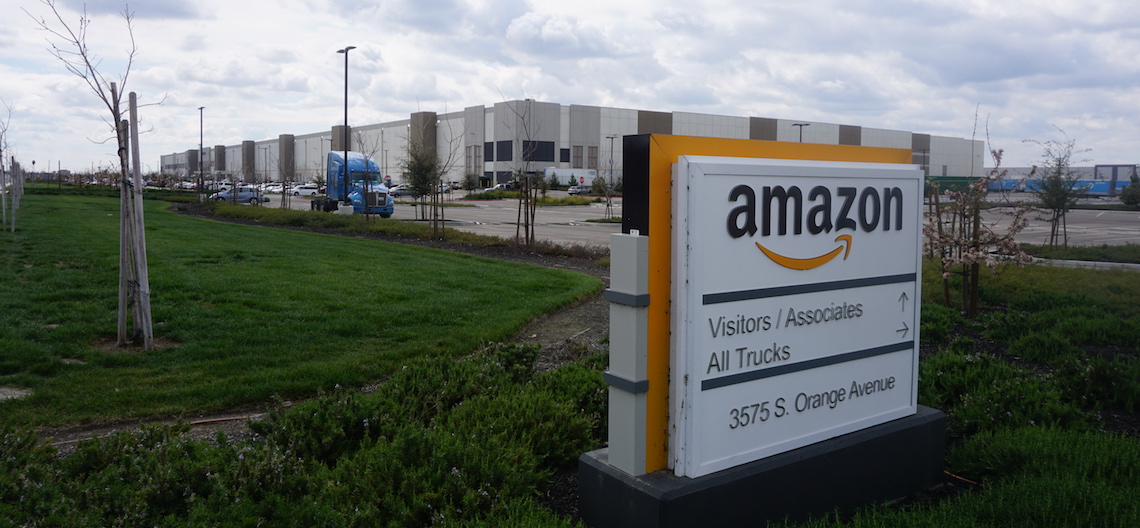
The Amazon "FAT 1" distribution center in Fresno. Photo by Edward Smith
Written by Julianna Morano with Fresnoland
This story was originally published by Fresnoland, a nonprofit news organization.
New regulations on where warehouses can be built are coming to California in 2026, and Fresno economic and environmental groups are already bracing for impact.
Assembly Bill 98, which received the governor’s signature Sept. 29, establishes new minimum distances between warehouses of at least 250,000 square feet and “sensitive receptors” like homes, schools, parks and hospitals.
That includes buffer zones of between 300 and 500 feet, depending on how the land is zoned where the warehouse is located.
The law has made strange bedfellows of local economic development leaders and environmental advocacy groups, with both sides slamming the new standards, though for different reasons.
On the economic development side, leaders are displeased that AB 98 creates “another mountain to climb over” for the logistics industry, which has been growing in the Central Valley.
“While we understand the intention behind setting environmental safeguards,” said Will Oliver, CEO of the Fresno County Economic Development Corporation, in an email, “the sweeping one size fits all approach and lack of flexibility may unintentionally discourage investment in our region.”
But for Leadership Counsel for Justice & Accountability, one of several environmental and public health advocacy groups in Fresno to oppose AB 98, the new required buffer zones fall “woefully” short of what’s needed.
“The setback is really inadequate,” said Asha Sharma, Leadership Counsel’s state policy manager, “and won’t offer the protections that communities really need to see from disturbances related to warehouses and the pollution related to warehouses.”
In the meantime, both city and county leaders are trying to understand what the law’s requirements mean for them – and how much implementation might cost.
Those costs will come from another one of AB 98’s requirements, which mandates that cities and counties update their general plans to specify truck routes to these warehouses that are away from homes, schools, hospitals and other sensitive sites.
That could spell tens to hundreds of millions of dollars in total one-time costs across the state, according to an analysis from the Senate Appropriations Committee.
Jennifer Clark, the City of Fresno’s planning director, confirmed that Fresno’s general plan, “like most” in cities across California, doesn’t include truck routes and will need to be updated under the new law, though she declined to estimate the cost.
While local governments study the local implications of AB 98, opponents await a clean-up bill that may or may not materialize.
“We hope to work with state leaders on potential cleanup legislation,” Oliver said, “to address these concerns.”
What does AB 98 say?
AB 98 requires that truck loading bays at warehouses 250,000 square feet or larger must be at least 300 feet from the property line of a home or other sensitive site if the land is zoned for industrial use.
Loading bays must maintain at least a 500-foot buffer from these sites if the land isn’t zoned industrial.
These buffer zones take effect for new warehouses starting in January 2026. The provisions don’t apply to existing warehouses, unless a developer is working to expand an existing facility that meets the minimum size requirement and is located within 900 feet of a home, school, park or healthcare facility.
AB 98 also requires updates to the circulation element of each city and county’s general plan to specify appropriate truck routes for the logistics industry to utilize. Cities and counties will have to complete those updates by January 2028.
The law includes additional language that warehouses should only be built along roadways that “predominantly serve commercial uses.”
What are local groups saying about AB 98?
Before it was signed, AB 98 drew criticism from many economic interests and environmental groups across the state, including in Fresno.
Local business leaders worry the law will make Fresno less competitive than other cities and counties in attracting lucrative e-commerce facilities.
“I believe it will make it more difficult for Fresno to build and attract these types of businesses and the jobs that come with them,” said Henry Perea, a former elected official and a consultant for the logistics industry, in an email. “Unfortunately, I think this law forces the development of new logistics centers in rural ag land areas.”
Clark, Fresno’s planning director, had a more optimistic read of how the new law will affect the city.
“I would say that it does provide a level playing field across the state in terms of requirements,” she said. “It allows us to evaluate projects the same way as other cities do.”
At the same time, others, including local elected officials, have voiced concerns that AB 98 will have unintended consequences for other industries.
In a Sept. 4 letter, Fresno County Board of Supervisors Chairman Nathan Magsig urged Gov. Gavin Newsom to kill the bill, citing worries that AB 98 would impact agricultural processing facilities “that are far different in size, scope, and impact than their urban counterparts.”
“Equally troubling,” he added, “the bill restricts the siting of logistics use projects to arterial roads, collector roads, major thoroughfares, or ‘local roads that predominantly serve commercial uses.’ These types of roads may not be available where these ag-related facilities need to be in rural areas.”
Environmental advocates have laid out very different issues with AB 98, calling it a weak bill that enshrines the status quo.
Ivanka Saunders, Leadership Counsel’s regional policy manager, said the group is fighting for the largest buffers possible to protect residents from the harmful effects of pollution from warehouses – and that they consider 1,000 feet to be the bare minimum.
“It’s not that we think it’s better – it’s the data,” Saunders said.
She cited a UC Merced health survey of Fresno residents published in May, which called for 1,000-foot buffers between the city’s truck routes and sensitive sites like homes and schools.
UC Merced researchers found a higher risk of infant mortality and preterm births among residents in south Fresno, which the study said was linked to their neighborhood’s closer proximity to the city’s truck routes.
A September 2022 report from Attorney General Rob Bonta’s office also called for 1,000-foot buffers between warehouse property lines and sensitive receptors like homes and schools.
What’s next?
Perea, the logistics industry consultant, alluded to talks of a cleanup bill that could affect the implications of AB 98 going forward, though he’s skeptical whether the state will ultimately see one.
“Talk of a cleanup bill emerged before the legislature voted on it,” he said. “Past legislative history will show that very few ‘cleanup’ bills ever come to fruition.”
Leadership Counsel, meanwhile, is setting their sights on the South Central Specific Plan in their efforts to establish bigger safeguards against warehouse pollution for residents of south Fresno.
The plan, still under the city’s review, lays out land use intentions for south Fresno, including which parts are zoned for industrial use.
But the new state standards will make it more difficult for them to push for the larger buffer zones and broader environmental protections for residents near warehouses.
“Now that we have these really weak standards, I think it’s going to make our work on the ground much harder,” Sharma said. “Because now it’s going to look like what we’re pushing for is so much more than these state standards.”








